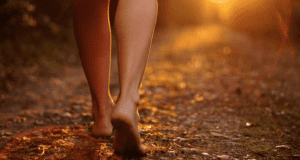Do you find yourself wearing shoes from the moment you wake up to the minute you go to bed? Do you experience pain in your foot when you walk barefoot? Many people are always in shoes and think it’s because walking barefoot is bad for you. In reality, it is just because they don’t have the mobility and strength in the muscles and ligaments of their feet anymore.
If you want to avoid pain walking barefoot and forget about feeling like you have to wear shoes 24/7, you came to the right place! At Robbins Rehabilitation West, we know all the physical therapy exercises that can alleviate your heel pain. Keep reading to find out what you can do to prevent pain while walking barefoot.
How the Foot Is Structured
Let’s start with the basic anatomy of your foot. A lot is going on in your foot. You have bones, joints, ligaments, tendons, muscles, connective tissues, and nerves that all need to work together and help form your anatomy of the foot.
Your foot is made up of three arches: two longitudinal (medial and lateral) arches and one anterior transverse arch. Although you are supposed to have three arches, many people only actually have one because the muscles making up those arches have not been able to maintain their strength.
When we wear shoes, our feet do not have to do as much work as walking barefoot. Our foot was made to do a lot of work and absorb shock from walking or running. Like anything, when we wear something that assists and provides support, our muscles don’t have to work as hard and they start to lose strength and our muscles atrophy.
Shoes do the same thing to our feet. Shoes are not meant to replace what your feet can do. Rather, they enhance what they can do and keep them safe from sharp objects that may hurt your foot.
Moving Out of Shoes
The first step in transitioning from wearing shoes 24/7 to going barefoot is to take a look at what type of shoe you are currently wearing. A good shoe is one with a flexible sole, a wide-toe box so your toes have room to spread while walking, and no heel lift.
If you are wearing a shoe with the exact opposite of what was just suggested, you would benefit from transitioning to the proper kind of shoe slowly to get your foot used to something with less of a cushion, heel, or with a wider toe box.
The second thing to do now is to start to get more mobility in your foot. You can do this by stretching your calves and toes and just moving your foot around a little more when not in a shoe. This may take time if you have been wearing a shoe that did not allow your foot to move at all. A good thing to start with is moving your foot through the ABCs to allow all motions of the foot.
Once you have more mobility in your foot, it is time to strengthen those muscles that you just elongated. This will help with developing the arches you are supposed to have, and they will help stabilize the foot again. The more strength and mobility you have in your foot alone, the less assistance you will need from your shoe, and the closer you will be to walking barefoot again! You can start with heel raises, toe raises, toe curls, and foot scoops.
Doing these kinds of exercises for foot and ankle pain will strengthen your foot and make it less likely that you will injure those areas.
Robbins Rehabilitation West Can Help with Foot Pain
In conclusion, you will need to start slow with this process. Chances are, you have been relying on shoes to help do the work your foot is supposed to be doing. This won’t happen overnight.
To start, do stretches and exercises daily, either in the morning, at night, or both! These are not hard exercises, and you can perform them while sitting at your desk at work or while watching TV at night. Next, start by walking around barefoot for 10 minutes each day and gradually increase the time each week until you are able to walk barefoot for a couple of hours at a time without any pain.
If you begin to experience pain in your foot that won’t go away, seek a medical expert. Physical therapy is a great way to start. At Robbins Rehabilitation West, we know the common causes for foot and ankle pain and how to apply physical therapy to help
We will be able to get that mobility and strength that you need to walk barefoot or be as minimalistic as possible without any pain and ensure you are doing exercises correctly and properly.
For those of you who want to learn how to prevent any injuries and avoid pain walking barefoot, sign up for our free course on the foot and ankle and learn some exercises you can do right now to help strengthen those muscles.
Call Robbins Rehabilitation West right now at 610-841-3555 to get started on the path to healing.


